Early exposure of infants to GI nematodes induces Th2 dominant immune responses which are unaffected by periodic anthelminthic treatment
- PMID: 19436745
- PMCID: PMC2677666
- DOI: 10.1371/journal.pntd.0000433
Early exposure of infants to GI nematodes induces Th2 dominant immune responses which are unaffected by periodic anthelminthic treatment
Abstract
We have previously shown a reduction in anaemia and wasting malnutrition in infants <3 years old in Pemba Island, Zanzibar, following repeated anthelminthic treatment for the endemic gastrointestinal (GI) nematodes Ascaris lumbricoides, hookworm and Trichuris trichiura. In view of the low intensity of worm infections in this age group, this was unexpected, and it was proposed that immune responses to the worms rather than their direct effects may play a significant role in morbidity in infants and that anthelminthic treatment may alleviate such effects. Therefore, the primary aims of this study were to characterise the immune response to initial/early GI nematode infections in infants and the effects of anthelminthic treatment on such immune responses. The frequency and levels of Th1/Th2 cytokines (IL-5, IL-13, IFN-gamma and IL-10) induced by the worms were evaluated in 666 infants aged 6-24 months using the Whole Blood Assay. Ascaris and hookworm antigens induced predominantly Th2 cytokine responses, and levels of IL-5 and IL-13 were significantly correlated. The frequencies and levels of responses were higher for both Ascaris positive and hookworm positive infants compared with worm negative individuals, but very few infants made Trichuris-specific cytokine responses. Infants treated every 3 months with mebendazole showed a significantly lower prevalence of infection compared with placebo-treated controls at one year following baseline. At follow-up, cytokine responses to Ascaris and hookworm antigens, which remained Th2 biased, were increased compared with baseline but were not significantly affected by treatment. However, blood eosinophil levels, which were elevated in worm-infected children, were significantly lower in treated children. Thus the effect of deworming in this age group on anaemia and wasting malnutrition, which were replicated in this study, could not be explained by modification of cytokine responses but may be related to eosinophil function.
Conflict of interest statement
The authors have declared that no competing interests exist.
Figures
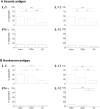
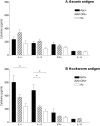
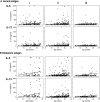
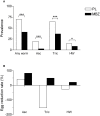
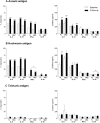
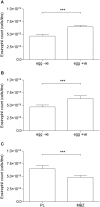
Similar articles
-
Cytokine response profiles predict species-specific infection patterns in human GI nematodes.Int J Parasitol. 2004 Oct;34(11):1237-44. doi: 10.1016/j.ijpara.2004.07.009. Int J Parasitol. 2004. PMID: 15491586
-
Effect of anthelminthic treatment on helminth infection and related anaemia among school-age children in northwestern Ethiopia.BMC Infect Dis. 2016 Oct 28;16(1):613. doi: 10.1186/s12879-016-1956-6. BMC Infect Dis. 2016. PMID: 27793110 Free PMC article.
-
Cellular responses and cytokine profiles in Ascaris lumbricoides and Trichuris trichiura infected patients.Parasite Immunol. 2002 Nov-Dec;24(11-12):499-509. doi: 10.1046/j.1365-3024.2002.00600.x. Parasite Immunol. 2002. PMID: 12694600
-
Effects of gastrointestinal nematode infection on the ruminant immune system.Vet Parasitol. 1997 Nov;72(3-4):327-37; discussion 337-43. doi: 10.1016/s0304-4017(97)00104-0. Vet Parasitol. 1997. PMID: 9460205 Review.
-
Role of the bovine immune system and genome in resistance to gastrointestinal nematodes.Vet Parasitol. 2001 Jul 12;98(1-3):51-64. doi: 10.1016/s0304-4017(01)00423-x. Vet Parasitol. 2001. PMID: 11516579 Review.
Cited by
-
Community deworming alleviates geohelminth-induced immune hyporesponsiveness.Proc Natl Acad Sci U S A. 2016 Nov 1;113(44):12526-12531. doi: 10.1073/pnas.1604570113. Epub 2016 Oct 17. Proc Natl Acad Sci U S A. 2016. PMID: 27791067 Free PMC article.
-
Anthelmintic drugs for treating ascariasis.Cochrane Database Syst Rev. 2020 Apr 14;4(4):CD010599. doi: 10.1002/14651858.CD010599.pub2. Cochrane Database Syst Rev. 2020. PMID: 32289194 Free PMC article.
-
Effect of Ascaris lumbricoides infection on T helper cell type 2 in rural Egyptian children.Ther Clin Risk Manag. 2016 Mar 9;12:379-85. doi: 10.2147/TCRM.S94019. eCollection 2016. Ther Clin Risk Manag. 2016. PMID: 27022269 Free PMC article.
-
Public health deworming programmes for soil-transmitted helminths in children living in endemic areas.Cochrane Database Syst Rev. 2019 Sep 11;9(9):CD000371. doi: 10.1002/14651858.CD000371.pub7. Cochrane Database Syst Rev. 2019. PMID: 31508807 Free PMC article.
-
Changes in plasma cytokines after treatment of ascaris lumbricoides infection in individuals with HIV-1 infection.J Infect Dis. 2010 Jun 15;201(12):1816-21. doi: 10.1086/652784. J Infect Dis. 2010. PMID: 20441516 Free PMC article. Clinical Trial.
References
-
- Crompton DW. Ascariasis and childhood malnutrition. Trans R Soc Trop Med Hyg. 1992;86:577–579. - PubMed
-
- Cooper ES, Bundy DA. Trichuris is not trivial. Parasitol Today. 1988;4:301–306. - PubMed
-
- Schad GA, Nawalinski TA. In: Historical introduction. Gilles HM, Ball PA, editors. Amsterdam: Elsevier; 1991.
-
- Stoltzfus RJ, Dreyfuss ML, Chwaya HM, Albonico M. Hookworm control as a strategy to prevent iron deficiency. Nutr Rev. 1997;55:223–232. - PubMed
-
- Brooker S, Peshu N, Warn PA, Mosobo M, Guyatt HL, et al. The epidemiology of hookworm infection and its contribution to anaemia among pre-school children on the Kenyan coast. Trans R Soc Trop Med Hyg. 1999;93:240–246. - PubMed
Publication types
MeSH terms
Substances
Grants and funding
LinkOut - more resources
Full Text Sources

